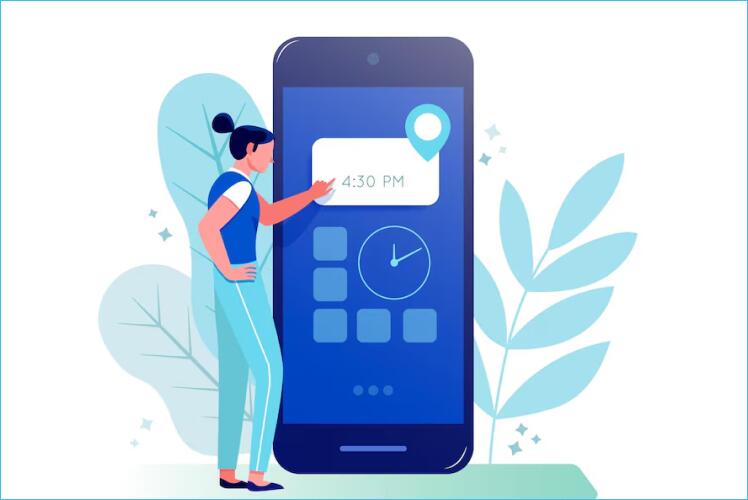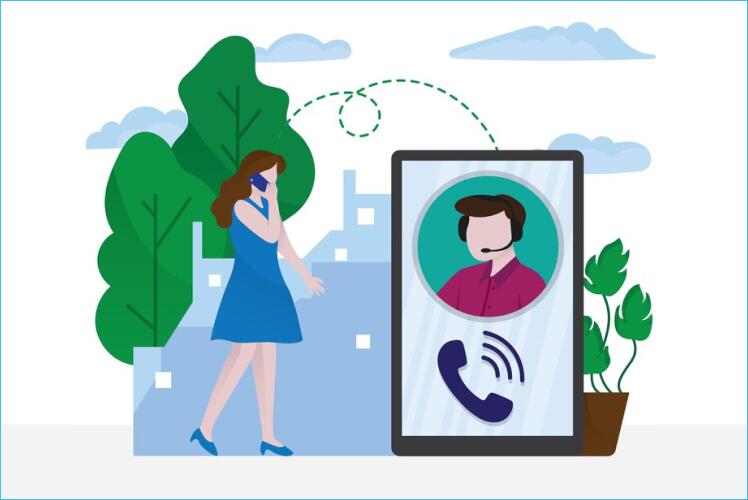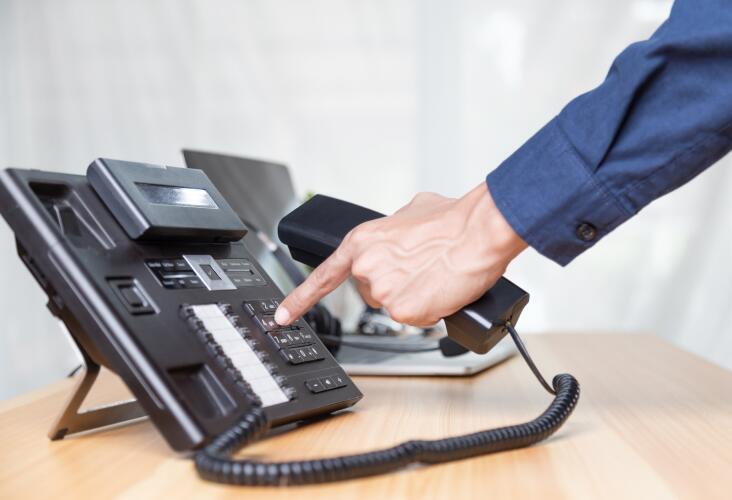
Did you miss an important call or receive a suspicious one? You have no clue about the caller, and now when you try to call back, you get the message that the number is unavailable. Certainly, you want to know how to find the owner of a VoIP number. But how do you trace the source of a VoIP phone call? This blog provides the best tried and tested ways to help you with a VoIP number lookup.
But first, let’s learn a bit about VoIP calls.
What is a VoIP Call?

VoIP calls, or Voice over Internet Protocol calls, is a type of communication that uses the Internet to transmit voice data rather than traditional telephone lines. Regular phone calls travel through copper wires or cellular networks, whereas VoIP calls convert voice into digital data packets and transmit them over the Internet as shown in the above image.
What is a VoIP Phone Number?
It is a phone number that operates over an internet connection. This means VoIP phone number users can make and receive calls from internet-connected devices such as mobile smartphones, computers, or VoIP phones. Some of the key features of VoIP phone numbers are:
- Internet-Based
VoIP phone numbers work via an internet connection, allowing calls from computers, mobile devices, or VoIP phones.
- Portable
These numbers offer location flexibility, i.e., they can be used from anywhere, unlike traditional numbers that are tied to a specific location.
- Cost-Effective
Compared to landline numbers, VoIP phone numbers are more affordable.
- Flexible
A VoIP phone number can be linked to multiple devices, which means users can receive calls on different gadgets.
- Versatility
VoIP services offer various features like call forwarding, voicemail-to-email, and auto attendants.
How to Differentiate Between a Regular Phone Number and VoIP Phone Number?
Usually, it’s difficult to differentiate between a regular call and a VoIP call. But the quickest way to check if a number is a VoIP number is to look for these signs:
- Displays an unfamiliar area code
- Has multiple zeros
- Includes a sequence of random digits
Remember that these indicators are not foolproof; there may be instances where it’s difficult to determine whether a call is VoIP.
The next section helps you understand the distinction between two types of VoIP numbers, fixed and non-fixed, based on how the number is registered and associated with a physical location or entity. By identifying a number as fixed and non-fixed VoIP number, you can determine the appropriate methods for identifying the owner and their location
What are Fixed and Non-Fixed VoIP Numbers?

Both fixed and non-fixed VoIP numbers allow you to make and receive calls over the Internet. However, their association with a physical location is what makes them different from one another. Now you may ask – how can a VoIP number be linked to a physical location since these are portable numbers working via the internet? Well, the below information answers your question.
When tracking down the owner of a VoIP number, it is important to know whether it is a fixed VoIP number or a non-fixed VoIP number from which you received the call.
-
Fixed VoIP Number
Like traditional landlines, fixed VoIP numbers are tied to a physical location, making them easier to trace. They are assigned to a specific address, such as a home or business. Though linked to a physical address, these numbers can still be used anywhere with an internet connection. Because of their association with local businesses or home addresses, fixed VoIP numbers usually have a local area code.
-
Non-Fixed VoIP Numbers
On the other hand, non-fixed VoIP numbers are not tied to a physical address; they are often associated with a geographical area like a city or country but do not have a specific street address. Phone numbers associated with mobile apps, web-based services, or virtual phone systems are non-fixed VoIP numbers. These numbers are also called virtual numbers and offer more flexibility, anonymity, and cost-effectiveness. A popular example is VoIP numbers provided by Google Voice for personal use or temporary needs.
This table will help you quickly understand the differences:
| Feature | Fixed VoIP | Non-Fixed VoIP |
| Physical Address | Yes, location-tied |
No, location-independent.
|
| Portability | Limited | High |
| E911 | Accurate location |
Location limitations
|
| Use Cases | Local businesses, residential |
Remote workers, virtual numbers
|
| Trust/Fraud | More trusted | Higher fraud risk |
| Costs | Higher | Lower |
How to Find the Owner of A VoIP Number?
Now, let’s delve into the core of our post: Can VoIP numbers be traced, and how to find the owner of a VoIP number? Yes, it is possible to trace VoIP numbers and various methods can help you. Let’s break down these approaches, one by one:
1. Check Your Call Log

While this may seem obvious, it should be the first method considered. Our phone devices keep call log records of all incoming and outgoing calls.
If you are using an iPhone, then simply open the ‘Phone App’ and tap ‘Recent’. In each entry, there’s information about the VoIP number, including the phone number, caller’s name, date, time, and duration of the call. If you want to see more details about a specific entry, then tap ‘More Info’.
On the Android platform, the process of seeing the call logs is almost similar.
2. Configure Caller Identification (Caller ID) on Your Device
The next easiest way to know the owner of a VoIP phone number is to install a caller ID feature on your phone. From the ‘Account Settings’ section of your phone device, you can activate this feature. Today, most smartphones come with a default caller ID feature. However, you can also install specific caller ID apps on your device. The VoIP service provider of the other party can also enable caller ID, displaying both the name and number of incoming calls.

However, there’s a likelihood that the calling party may alter their name and information used on Caller ID. This practice is called ‘Caller ID Spoofing’. Spam callers often use it to present false information, wherein the number looks similar to yours, someone you know, or has a local area code, so the chances of you answering are high.
3. Contact Your VoIP Service Provider

Another effective way to find the owner of a VoIP number is to reach out to your VoIP provider. It is important to note down the timing of the specific call, the phone number, and any other details associated with the VoIP number in question. You can simply connect with the customer service of your VoIP provider and share this information. VoIP service providers usually have records linking the number to an account holder. However, if the caller is not registered or has used a counterfeit IP address, then your VoIP provider might face challenges in tracking the real source of the phone number.
One important thing to remember – in instances where the caller is using a VPN or the IP address is used by multiple numbers, your VoIP provider might not be able to extract the owner of the VoIP number.
4. Leverage Online Reverse Phone Lookup Services

This is a quick and straightforward way to figure out the real owner of a VoIP number (but you need a lot of luck). VoIP reverse phone search websites or tools like Whitepages or Spokeo offer the facility of reverse phone lookups as they include VoIP phone numbers in their databases. You just have to directly put the phone number in the search, and you will receive information about the owner of the phone number, like their name, address, etc.
The best part is that you don’t need to download or install any application; you simply browse a reverse phone lookup website and perform your search. Moreover, there are multiple online services, which means you can try as many as you want.
Another popular service is Inteliquent phone number lookup, which is a telecom company that offers various services, including phone number lookup. You can visit their website or use their API to enter the phone number you want to look up. After submission, the service will search its database and provide you with information associated with that number. You will typically need to have a subscription or pay a fee to use Inteliquent’s service.
Most of the reverse phone lookup services are offered free of cost, but some do require a subscription fee as mentioned above. Also, there’s no guarantee about the accuracy of the information provided by these services. Furthermore, this method might not work in cases where the VoIP number is new or has strict privacy settings.
5. Using Hardphone or Softphone Packet Analyzers
Packet Analyzers are software programs that capture and analyze the data packets flowing across a network. In short, they offer a glimpse into the world behind the call. Using packet analyzers with hard phones or softphones, you can analyze the network traffic during the call and extract IP addresses associated with the caller and callee.
Hardphones and softphones use the SIP protocol to connect with a central hub in the network. For the desk phone setup, the packet analyzer needs to be set up on the network itself, and for computer call programs, the packet analyzer can be downloaded.
However, using this technique can be tricky and requires some technical knowledge. It is important to note that the IP address may not directly reveal the identity of the owner of the VoIP number, but it can provide clues like location or an associated service provider.
6. Perform an IP Address Lookup

This is more of an advanced approach where obtaining the IP address of the caller is a prerequisite. To acquire the IP address of the caller, you can use IP lookup tools or perform a WHOIS lookup that can provide you with information about a specific IP address such as the owner of the IP address, the location of the IP address of the caller, the Internet Service Provider (ISP), and other relevant details. This information can help identify the general location of a VoIP user, especially if they’re using a fixed VoIP service.
7. CNAM Lookup to Find the Owner of a VoIP Number
If you are a tech-savvy user, then this technique might work for you. The first and foremost requirement of this method is to give your VoIP service provider a valid reason for investigating a VoIP phone number. Recipients facing harassment, unsolicited calls, or prank calls make a convincing reason, otherwise, the VoIP provider might decline your request.
You can then directly request a CNAM (Caller Name Identification) from the service provider, or if you have the required technical skills, you can perform a CNAM lookup.
8. Using the VoIP Address Domain
Every VoIP call is linked to a unique domain address, which looks like a regular phone number or an email address. Here, you need to check the call history of your phone and find the VoIP service provider by identifying the domain name from the address. Once you can find the service provider, you search for the owner of the VoIP number.
An example of the VoIP call log that displays the associated domain name is:
- Domain: voipserviceprovider.com
- Date/Time: 2024-08-20 10:40 PM
- Call Duration: 06 minutes
However, the domain name can also be in the form of a string of numbers, such as 203.0.113.12, representing the origin of the VoIP call.
Now, that you have a domain name, you can trace it back to an IP address by using the available tools for domain-to-IP conversion.
9. Check Your Call Records on the Invoice
VoIP service providers also provide records of your incoming and outgoing calls, just like telephone invoices. Keeping in mind the exact time of the call, you can review your VoIP call details and identify the suspected call. Once you have some information about the caller, you may apply any of the tactics, whichever is applicable, mentioned here to find the owner of the VoIP number.
10. Use the Automated Service (*69)

This one is a really quick trick. You just need to dial *69 on your phone, and it will connect you to an automatic system. This service provides you with information regarding the last or most recent incoming call. So if it’s a VoIP number, then it might be the number you are looking for. The information provided by the service includes details like the timing of the call and the origin, i.e., the location of the caller.
11. Harness the Power of Search Engines
Search engines are our best friends when finding answers to something. So when searching out the owner of a VoIP call, we must not underestimate the power of search engines. Open Google, Bing, or any other search engine of your choice and input the VoIP number you want to trace. While sifting through the search results, you may stumble upon mentions of the VoIP number and to whom it belongs in online forums, classified ads, and other public platforms.
12. Delve into Social Media and Online Directories
Social media is a giant source of information in modern life. Often, social media accounts or profiles are interconnected with the phone number of the account owner. You may perform thorough research on popular social media platforms like Facebook and LinkedIn. Additionally, you can search through online directories like Yelp, to see if the phone number is linked to a business.
13. Explore your Connections

At times, the solution to a problem lies closer to home. You may want to check within your network and see if anyone from your connections recognizes the number. Often personal connections can provide useful information that might not be publicly available.
14. Consult Public Records
The effectiveness of this approach depends heavily on your location’s regulation and your jurisdiction. Exploring certain public records can sometimes provide valuable information about the owner of a VoIP number. These records may include property records, business registrations, and court documents. You may find and access these records on certain websites. Although it may require a subscription to access these records.
15. Consider Legal Resources
Suppose you are experiencing abusive or prank calls, and you suspect that the VoIP number is being used for illegal activities or harassment. In that case, it is advisable to notify your local authorities. You can inform them that you have been receiving calls that are breaking your peace of mind. Try to provide them with as much information as you have about the calls because it will help the authorities in their investigation. Involving law enforcement may compel service providers to disclose the information.
Conclusion
By appropriately implementing the above-mentioned methods, your chances of finding some valuable information about the owner of a VoIP number increase significantly. You may combine these techniques and utilize specialized tools to get some leads, however, there’s no guaranteed way to find the owner of a VoIP number. Always remember that if the number is being used for malicious intent, it is best to report it to the appropriate authorities.
Frequently Asked Questions
Can I trace a VoIP number like a regular phone number?
Tracing a VoIP number is more complex than tracing a traditional phone number due to its non-geographical nature and varied service providers.
What information do I need to find the owner of a VoIP number?
You need the full VoIP number and any additional context, such as the service provider or region, to help identify the owner.
Are there legal considerations when tracing a VoIP number?
Yes, privacy laws apply. Ensure you have a legitimate reason and comply with relevant laws before attempting to trace a VoIP number.
Can reverse phone lookup services help with VoIP numbers?
Reverse phone lookup services may not be effective for all VoIP numbers, as many are not listed in public directories.
What should I do if I suspect fraud with a VoIP number?
Report suspected fraudulent activities to local law enforcement or cybercrime units with all relevant details, and avoid contacting the suspected party.
Can law enforcement trace VoIP numbers?
Yes, in case of suspected fraud or criminal activities, law enforcement agencies can trace VoIP numbers. They can do so by obtaining call records and registration details from service providers. However, if the caller uses encryption, VPNs, or fake credentials, tracing may be more challenging.
How to trace a VoIP number if the caller is using VPN?
It is difficult to trace a VoIP number when the caller is using VPN services because it hides the real identity of the caller’s real IP address. However, VoIP service providers store records of call logs and account information that may be helpful.
Note: This post was updated with latest information on 20-03-25.




























